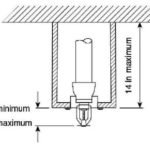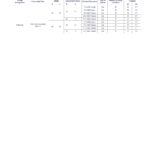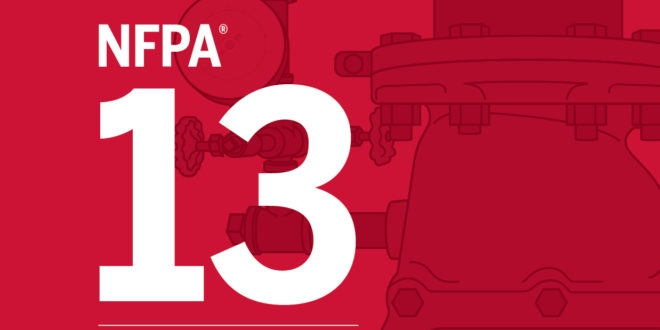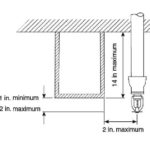2019 Edition New Format Aligns with System Design Process
The 2019 edition of NFPA 13, Standard for the Installation of Sprinkler Systems, will introduce a new era in terms of the format and layout of the standard. This reorganization was done to better match and align with the fire sprinkler system design/analysis processes, as opposed to current and past editions which tended to jump around, with multiple redundancies in some cases.
In this revised edition, relevant information has been grouped together to limit that “jumping around” to find all of the requirements for things like fire department connections, which in prior editions had requirements in three different chapters.
Redundancies have been removed from the standard wherever possible to avoid confusion. This is especially true for chapters associated with storage occupancies, wherein prior editions the user would find the required design criteria in the chapter(s) associated with the commodity and the storage arrangement.
Within each storage chapter in prior editions, we would find criteria for systems designed with control mode, density area (CMDA) standard spray sprinklers, control mode specific application (CMSA) sprinklers and early suppression fast response (ESFR) sprinklers based primarily on a 20-ft storage height. Depending on the sprinkler technology or type chosen, modifiers for storage height greater and lesser than 20 ft could be applied and storage at greater heights than 25 ft or 30 ft were provided in another section of the chapter(s).
With the new format (as related to storage occupancy design criteria) we still need to know the commodity classification and the storage arrangement but now, the chapters are based on the sprinkler technology or type of sprinkler (CMDA, CMSA or ESFR) we plan to use for protection the facility or portion of the facility under review.

Beam. Reproduced with permission from NFPA 13-2019, Installation of Sprinkler Systems, Copyright © 2018, National Fire Protection Association, Quincy, MA. This reprinted material is not the complete and official position of the NFPA on the
referenced subject, which is represented only by the standard in its entirety which may be obtained through the NFPA website at www.nfpa.org.
Comments from newer users of the sprinkler standard often referred to a lack of a linear path from water supply considerations through the design and installation process, ending up with acceptance testing. The intent of the reorganization was to provide a sequential layout based on how a system is designed and built. There are now two general requirements chapters which actually provide general requirements and the old chapter 8, which in prior editions tended to collect requirements that didn’t seem to fit elsewhere, has been split into multiple chapters.
Another change that may not seem obvious to users in the United States is a global look at and revision of metric values that make more sense for S.I. users.
In general terms, most of the changes for this cycle are related to the re-organization and clean up of redundancies and there are not a lot of technical changes overall to NFPA 13; NFPA 13D, Standard for the Installation of Sprinkler Systems in One-and Two-Family Dwellings and Manufactured Homes; or NFPA 13R, Standard for the Installation of Sprinkler Systems in Low-Rise Residential Occupancies.
The new chapter layout will look like this:
- Chapters 1 and 2 remain the same.
- Chapter 3 has been organized alphabetically.
- Chapter 4 General Requirements (to be expanded as “true” general requirements chapter)
- Chapter 5 Water Supplies
- Chapter 6 Installation of Underground Piping (from NFPA 24)
- Chapter 7 System Components and Hardware
- Chapter 8 System Requirements
- Chapter 9 Sprinkler Location Requirements
- Chapter 10 Installation Requirements for Standard Spray Sprinklers
- Chapter 11 Installation Requirements for Extended Coverage Sprinklers
- Chapter 12 Installation Requirements for Residential Sprinklers
- Chapter 13 Installation Requirements for CMSA Sprinklers
- Chapter 14 Installation Requirements for ESFR Sprinklers
- Chapter 15 Installation Requirements for Special Sprinklers
- Chapter 16 Installation of Piping, Valves, and Appurtenances
- Chapter 17 Installation Requirements for Hanging and Support Systems
- Chapter 18 Installation Requirements for Seismic Protection
- Chapter 19 Design Approaches and Calculations
- Chapter 20 General Requirements for Storage Occupancies
- Chapter 21 Standard Spray Sprinkler Requirements for Storage Applications
- Chapter 22 CMSA Requirements for Storage Applications
- Chapter 23 ESFR Requirements for Storage Applications
- Chapter 24 Alternative Sprinkler System Designs
- Chapter 25 In-rack Sprinklers
- Chapter 26 Special Occupancy Requirements
- Chapter 27 Systems Acceptance
- Chapter 28 Existing System Modifications
- Chapter 29 Marine Systems
- Chapter 30 System Inspection, Testing, and Maintenance

Figure 2. NFPA 13, 2019 edition Figure 12.1.8.1.2(b) Position of Sprinkler Adjacent to Beam. Reproduced with permission from NFPA 13-2019, Installation of Sprinkler Systems, Copyright © 2018, National Fire Protection Association, Quincy, MA. This reprinted material is not the complete and official position of the NFPA on the referenced subject, which is represented only by the standard in its entirety which may be obtained through the NFPA website at www.nfpa.org.
As noted, there are not a lot of technical changes for this cycle but here are some of the significant changes you will see:
- Where an air compressor is the dedicated air supply, it shall be installed in accordance with NFPA 70®, National Electrical Code®, Article 430. This clarifies the requirement to hard wire dedicated compressors as opposed to having one that plugs into an electrical outlet and states that the disconnecting means for an automatic air compressor shall not be a general-use light switch or a cord- and plug-connected motor.
- Effective January 1, 2021, removal of an electric actuator from the pre-action or deluge valve that it controls shall result in an audible and visual indication of system impairment at the system releasing control panel.
- Residential sprinklers shall be permitted in dwelling units and their adjoining corridors, provided they are installed in conformance with their listing and when installed under the following conditions:
– A flat, smooth, horizontal ceiling
– A flat, horizontal, beamed ceiling
– A smooth, flat, sloped ceiling with no beams
– A sloped ceiling with beams up to 14-in. (355-mm) deep
– A sloped ceiling with beams of any depth
- Where construction features or other special conditions exist that are outside the scope of sprinkler listings, listed sprinklers shall be permitted to be installed beyond their listing limitations when acceptable to the authority having jurisdiction. This has been done several times by the technical committee such as allowing sidewall sprinklers to be used beneath overhead doors or applying sprinklers listed for concealed sprinklers less than 3-ft high to be used with composite wood joists.
- Automated Valves.
– A listed indicating valve with automated controls shall be permitted.
– A listed automated water control valve assembly with a reliable position indication connected to a remote supervisory station shall be permitted.
– An automated water control valve shall be able to be operated manually as well as automatically.
- All the wedge anchor table values have been revised.
- Cavities within unsprinklered wall spaces shall not require a minimum area of sprinkler operation of 3,000 ft<sup>2</sup> (279 m<sup>2</sup>): (Section 9.2.1.3 allows for wall cavities over a certain size to be unsprinklered).
- 25.2 K-Factor design criteria has been added to the CMSA design criteria tables based on testing from UL.
- New requirements for in-rack sprinklers in combination with ESFR ceiling level design.
- New criteria for exposed expanded group A plastic.
- Working plan submittals shall include the following:
– Working plans of the system(s), per 4.6.3.
– Hydraulic calculations where systems are required to be calculated.
– Data sheets for the system components where required by the Authority Having Jurisdiction (AHJ).
– Signed owner’s certificate.
– Submittals shall be permitted to be in electronic format when approved by the authority having jurisdiction.
- A copy of the approved plans shall be given to the owner or owner’s representative.

The following changes are found in NFPA 13D and NFPA 13R:
- Pendent, recessed pendent, and flush-type pendent sprinklers shall be permitted to be installed directly under a beam having a maximum depth of 14 in. (350 mm) with the sprinkler deflector 1-in. to 2-in. (25-mm to 50-mm) below the beam, or in accordance with the manufacturer’s instructions for recessed or flush sprinklers if the deflector is less than 1-in. (25-mm) below the beam (as shown in Figure 1).
- Pendent sprinklers shall be permitted to be installed adjacent to beams where the vertical centerline of the sprinkler is no greater than 2 in. (50 mm) from the edge of the beam and with the sprinkler deflector 1-in. to 2-in. (25-mm to 50-mm) below the beam, or in accordance with the manufacturer’s instructions for flush sprinklers if the deflector is less than 1-in. (25-mm) below the beam, as shown in Figure 12.1.8.1.2(b) (as shown in Figure 2).
- Where nonmetallic pipe installed in accordance with 16.3.9.6 supplies sprinklers in a private garage within a dwelling unit not exceeding 1000 ft2 (93 m2) in area, it shall be permitted to be protected from the garage compartment by not less than the same wall or ceiling sheathing that is required by the applicable building code.
The new edition(s) were not available at the time of this writing this article; however, once we receive the printed copies, we will follow up with additional articles in future issues of Sprinkler Age to help members digest and apply the revisions and requirements. AFSA’s Engineering & Technical Services Department provides assistance and informal interpretations for members to assist with application of the codes and standards used every day. Please remember to include the year or edition of the standard being applied when submitting a question and note that the more specific information you can provide, the more specific response staff can provide in return.
 ABOUT THE AUTHOR: Bob Caputo, vice president of Tech Support and Training at Fire & Life Safety America, is chairman of the NFPA 16 Technical Committee and a member of multiple NFPA committees including NFPA 13 and NFPA 25. He is a contributor of the NFPA 13 and NFPA 25 Handbooks, and the NFPA Inspection Manual. A senior member of NFPA and AFSA faculties, Caputo has written and presented seminars throughout the world on fire protection and life safety systems. He is a regular speaker at NFPA and AFSA annual conventions and is the author of AFSA’s Project Management Tools program. He was named San Diego County “Fire Prevention Officer of the Year” in 1994 and Fire Protection Contractor magazine’s Person of the Year in 1997. Caputo attended the University of Albuquerque, New Mexico, and is a U.S. Navy veteran.
ABOUT THE AUTHOR: Bob Caputo, vice president of Tech Support and Training at Fire & Life Safety America, is chairman of the NFPA 16 Technical Committee and a member of multiple NFPA committees including NFPA 13 and NFPA 25. He is a contributor of the NFPA 13 and NFPA 25 Handbooks, and the NFPA Inspection Manual. A senior member of NFPA and AFSA faculties, Caputo has written and presented seminars throughout the world on fire protection and life safety systems. He is a regular speaker at NFPA and AFSA annual conventions and is the author of AFSA’s Project Management Tools program. He was named San Diego County “Fire Prevention Officer of the Year” in 1994 and Fire Protection Contractor magazine’s Person of the Year in 1997. Caputo attended the University of Albuquerque, New Mexico, and is a U.S. Navy veteran.
IMPORTANT NOTICE: The article and its content is not a Formal Interpretation issued pursuant to NFPA Regulations. Any opinion expressed is the personal opinion of the author and presenter and does not necessarily present the official position of the NFPA and its Technical Committee.
EDITOR’S NOTE: For more information about AFSA’s informal interpretations service for members, visit firesprinkler.org.
 Sprinkler Age A Publication of the American Fire Sprinkler Association
Sprinkler Age A Publication of the American Fire Sprinkler Association

